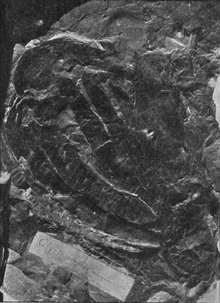| Vernonopterus Temporal range: Westphalian,
| |
|---|---|

| |
| Type specimen of V. minutisculptus | |
| Scientific classification | |
| Domain: | Eukaryota |
| Kingdom: | Animalia |
| Phylum: | Arthropoda |
| Subphylum: | Chelicerata |
| Order: | †Eurypterida |
| Superfamily: | †Mycteropoidea |
| Family: | †Hibbertopteridae |
| Genus: | †Vernonopterus Waterston, 1968 |
| Species: | †V. minutisculptus
|
| Binomial name | |
| †Vernonopterus minutisculptus (Peach, 1905)
| |
Vernonopterus is a genus of eurypterid, a group of extinct aquatic arthropods. Fossils of Vernonopterus have been discovered in deposits of the Carboniferous period in Scotland. The name of the genus derives from the location where the only known fossil has been discovered, Mount Vernon near Airdrie in Lanarkshire, Scotland. A single species of Vernonopterus is recognized, V. minutisculptus, based on fragmentary fossilized tergites, segments on the upper side of the abdomen. The species name minutisculptus refers to the ornamentation of scales that covers the entirety of the preserved parts of the eurypterid.
Although little can confidently be said about the appearance of Vernonopterus, it is likely to have been similar to its relatives within the hibbertopterid family, Hibbertopterus and Campylocephalus. The hibbertopterids were large eurypterids with broad heads and bodies and appendages developed for sweep-feeding, a technique involving blade-like adaptations to search for food in the substrate of its living environment. Compared to both Hibbertopterus and Campylocephalus, Vernonopterus would have been small, reaching lengths of about 50 centimetres (19.7 inches).